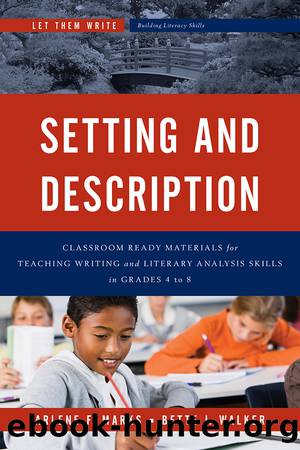Setting and Description by Marks Arlene F.;Walker Bette J.; & Bette J. Walker

Author:Marks, Arlene F.;Walker, Bette J.; & Bette J. Walker [Marks, Arlene F. & Walker, Bette J.]
Language: eng
Format: epub
Publisher: Rowman & Littlefield Unlimited Model
Published: 2015-08-15T00:00:00+00:00
STR 6
STR 7
INCLUDING SENSORY DETAIL SKILL 3
USING THE SENSE OF TASTE
CONCRETE MATERIALS
â¢STR 8âEXAMPLE PARAGRAPHS Sheetâclass set
â¢STR 9âSENSE OF TASTE Chartâdouble-sidedâa class set
â¢Small paper plates and small medicine cupsâ1 of each per student
â¢Sugar, salt, parsley, lemon juice, slices of bread
TWO-WEEK MODULE
PURPOSE: Young authors will learn about and practice making their writing more vivid by including interesting descriptions of taste where appropriate.
BEFORE DAY 1
Since this module includes the ingestion of food, the teacher will need to ascertain whether any of the students have allergies (to the gluten in the bread, for example). A letter home or an e-mail sent to parents would be a wise precaution, along with a visit to the school office to double-check studentsâ health records.
DAY 1
STEP 1: The teacher gives a copy of the EXAMPLE PARAGRAPHS sheet to each student and reads three of the examples aloud while students follow along on the handout. After each example, the teacher pauses and asks one or more of the following questions: What emotion is the tasting character experiencing in this example? What memory does the taste bring to his or her mind? What association or comparison does the character make between this flavor and something else? Why is the comparison effective?
The teacher can explain to the class that description that brings out memories and emotions in the reader is said to be evocative. This is a goal that student authors should be striving to achieve whenever they write descriptively. (At this time, students can also begin drawing up a list of words and phrases used to describe various foods, for possible inclusion in their writing assignments.)
STEP 2: The teacher then distributes to each student the following: a slice of bread, a spoonful each of sugar and salt, and a sprig of parsley, all on a small paper plate, as well as a spoonful of lemon juice in a small medicine cup. Finally, the teacher hands out a copy of the SENSE OF TASTE chart to each student.
STEP 3: Working independently, each student samples the salt, sugar, parsley, and lemon juice in any order, one item at a time, filling out a row of the SENSE OF TASTE chart for each one before moving on to the next. The bread should be used to clear the palate between foodstuffs, to avoid mixing flavors. It should be explained to the students that these are the four basic tastes: sweet, sour, salty, and bitter. Every other taste is some combination of these. At the teacherâs discretion, students can form groups of three or four to share ideas during this activity. Allow fifteen minutes.
STEP 4: Each student now selects one of the past experiences mentioned on his or her chart and proceeds to first-draft a short description of this scene, including as much as possible of the information recorded in the same-numbered row of the chart. Allow ten minutes. If time permits, each author reads over his or her completed scene to fill in any missing words and correct any punctuation errors.
Download
This site does not store any files on its server. We only index and link to content provided by other sites. Please contact the content providers to delete copyright contents if any and email us, we'll remove relevant links or contents immediately.
The Art of Coaching Workbook by Elena Aguilar(50161)
Trainspotting by Irvine Welsh(21070)
Twilight of the Idols With the Antichrist and Ecce Homo by Friedrich Nietzsche(18316)
Fangirl by Rainbow Rowell(8812)
Periodization Training for Sports by Tudor Bompa(7939)
Change Your Questions, Change Your Life by Marilee Adams(7399)
This Is How You Lose Her by Junot Diaz(6469)
Asking the Right Questions: A Guide to Critical Thinking by M. Neil Browne & Stuart M. Keeley(5378)
Grit by Angela Duckworth(5316)
Red Sparrow by Jason Matthews(5218)
Paper Towns by Green John(4820)
Room 212 by Kate Stewart(4759)
Ken Follett - World without end by Ken Follett(4461)
The Sports Rules Book by Human Kinetics(4090)
Housekeeping by Marilynne Robinson(4078)
Double Down (Diary of a Wimpy Kid Book 11) by Jeff Kinney(3950)
Papillon (English) by Henri Charrière(3937)
The Motorcycle Diaries by Ernesto Che Guevara(3798)
Exercise Technique Manual for Resistance Training by National Strength & Conditioning Association(3794)
